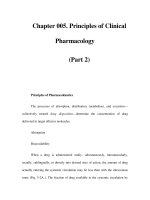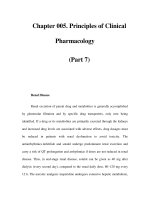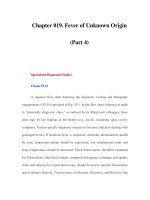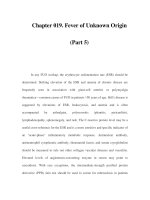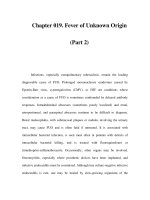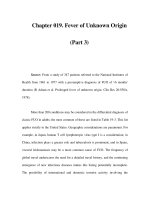Chapter 019. Fever of Unknown Origin (Part 2) pptx
Bạn đang xem bản rút gọn của tài liệu. Xem và tải ngay bản đầy đủ của tài liệu tại đây (60.73 KB, 6 trang )
Chapter 019. Fever of Unknown Origin
(Part 2)
Infections, especially extrapulmonary tuberculosis, remain the leading
diagnosable cause of FUO. Prolonged mononucleosis syndromes caused by
Epstein-Barr virus, cytomegalovirus (CMV), or HIV are conditions whose
consideration as a cause of FUO is sometimes confounded by delayed antibody
responses. Intraabdominal abscesses (sometimes poorly localized) and renal,
retroperitoneal, and paraspinal abscesses continue to be difficult to diagnose.
Renal malacoplakia, with submucosal plaques or nodules involving the urinary
tract, may cause FUO and is often fatal if untreated. It is associated with
intracellular bacterial infection, is seen most often in patients with defects of
intracellular bacterial killing, and is treated with fluoroquinolones or
trimethoprim-sulfamethoxazole. Occasionally, other organs may be involved.
Osteomyelitis, especially where prosthetic devices have been implanted, and
infective endocarditis must be considered. Although true culture-negative infective
endocarditis is rare, one may be misled by slow-growing organisms of the
HACEK group (Haemophilus aphrophilus, Actinobacillus
actinomycetemcomitans, Cardiobacterium hominis, Eikenella corrodens, and
Kingella kingae; Chap. 140), Bartonella spp. (previously Rochalimaea),
Legionella spp., Coxiella burnetii, Chlamydophila psittaci, and fungi. Prostatitis,
dental abscesses, sinusitis, and cholangitis continue to be sources of occult fever.
Fungal disease, most notably histoplasmosis involving the
reticuloendothelial system, may cause FUO. FUO with headache should prompt
examination of spinal fluid for Cryptococcus neoformans. Malaria (which may
result from transfusion, the failure to take a prescribed prophylactic agent, or
infection with a drug-resistant strain) continues to be a cause, particularly of
asynchronous FUO. A related protozoan infection, babesiosis, may cause FUO
and is increasing in geographic distribution and in incidence, especially among the
elderly and immunosuppressed.
In most earlier series, neoplasms were the next most common cause of
FUO after infections (Table 19-1). In more recent series, a decrease in the
percentage of FUO cases due to malignancy was attributed to improvement in
diagnostic technologies—in particular, high-resolution tomography, MRI, PET
scanning, and tumor antigen assays. This observation does not diminish the
importance of considering neoplasia in the initial diagnostic evaluation of a patient
with fever. A number of patients in these series had temporal arteritis, adult Still's
disease, drug-related fever, and factitious fever. In recent series, ~25–30% of cases
of FUO have remained undiagnosed. The general term noninfectious inflammatory
diseases applies to systemic rheumatologic or vasculitic diseases such as
polymyalgia rheumatica, lupus, and adult Still's disease as well as to
granulomatous diseases such as sarcoidosis and Crohn's and granulomatous
hepatitis.
In the elderly, multisystem disease is the most frequent cause of FUO,
giant-cell arteritis being the leading etiologic entity in this category. In patients
>50 years of age, this disease accounts for 15–20% of FUO cases. Tuberculosis is
the most common infection causing FUO in the elderly, and colon cancer is an
important cause of FUO with malignancy in this age group.
Many diseases have been grouped in the various studies as "miscellaneous."
On this list are drug fever, pulmonary embolism, factitious fever, the hereditary
periodic fever syndromes (familial Mediterranean fever, hyper-IgD syndrome,
tumor necrosis factor receptor–associated periodic syndrome, familial cold
urticaria, and the Muckle-Wells syndrome), and Fabry disease.
A drug-related etiology must be considered in any case of prolonged fever.
Any febrile pattern may be elicited by a drug. Virtually all classes of drugs cause
fever, but antimicrobial agents (especially β-lactam antibiotics), cardiovascular
drugs (e.g., quinidine), antineoplastic drugs, and drugs acting on the central
nervous system (e.g., phenytoin) are particularly common causes.
It is axiomatic that, as the duration of fever increases, the likelihood of an
infectious cause decreases, even for the more indolent infectious etiologies (e.g.,
brucellosis, paracoccidioidomycosis, malaria due to Plasmodium malariae). In a
series of 347 patients referred to the National Institutes of Health from 1961 to
1977, only 6% had an infection (Table 19-2). A significant proportion (9%) had
factitious fevers—i.e., fevers due either to false elevations of temperature or to
self-induced disease. A substantial number of these factitious cases were in young
women in the health professions. It is worth noting that 8% of the patients with
prolonged fevers (some of whom had completely normal liver function studies)
had granulomatous hepatitis, and 6% had adult Still's disease. After prolonged
investigation, 19% of cases still had no specific diagnosis. A total of 27% of
patients had no actual fever during inpatient observation or had an exaggerated
circadian temperature rhythm without chills, elevated pulse, or other
abnormalities.
Table 19-2 Causes of FUO Lasting >6 Months
Cause Cases, %
None identified 19
Miscellaneous causes 13
Factitious causes 9
Granulomatous hepatitis 8
Neoplasm 7
Still's disease 6
Infection 6
Collagen vascular disease 4
Familial Mediterranean fever
3
No fever
a
27
a
No actual fever observed during 2–3 weeks of inpatient observation.
Includes patients with exaggerated circadian rhythm.

